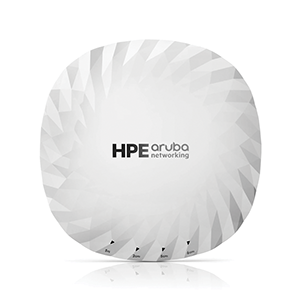What does Wi-Fi 7 mean for South African networks?
31 October 2025
Telecoms, Datacoms, Wireless, IoT
By Waseem Bhamjee, Duxbury Networking.
It is easy to get swept up in the jargon of new technology releases where everything is faster, smarter, and more efficient, but what matters in the real world is whether these advances solve actual problems. With Wi-Fi 7 (802.11be), we are finally looking at a standard that was built not just for more devices, but for the new way networks are used: always on, always mobile, and increasingly business-critical.
As South Africa’s technology landscape adapts to growing digital demands, from smart campuses to connected healthcare and automation-heavy manufacturing, the arrival of Wi-Fi 7 presents a timely evolution, and HPE Aruba Networking’s new 700 Series access points provide a glimpse into what Wi-Fi 7 can deliver.
Beyond speed: What Wi-Fi 7 changes
The most obvious benefit of Wi-Fi 7 is speed. Thanks to support for 320 MHz channels and 4K QAM modulation, the new standard effectively doubles the throughput of Wi-Fi 6E.
It is not just about raw performance. Multi-Link Operation (MLO) allows for simultaneous use of different frequency bands, like 5 GHz and 6 GHz, to increase reliability and reduce latency. That makes a major difference in environments where stability is just as important as speed. For instance, think of real-time applications like AR/VR, remote operations, or mission-critical video calls.
The new 700 Series range (that includes the AP-725, AP-735, and AP-755) is Aruba’s Wi-Fi 7 portfolio designed for the real world complexity of enterprise wireless environments. Here is how they differ:
• AP-725 is the entry point: compact, efficient, and ideal for general-purpose deployments like classrooms or office floors.
• AP-735 steps up with more performance and coverage, aimed at higher density environments like conference venues or retail floors.
• AP-755 is the top-end unit, designed for ultra-dense, high-capacity environments such as stadiums, hospitals, or university campuses.
All models are equipped with tri-band radios (2,4 GHz, 5 GHz, and 6 GHz), multi-gigabit uplinks, and built-in IoT support for Zigbee and Bluetooth. Crucially, they also integrate directly into the Aruba Central AI-powered management platform, giving IT teams real-time visibility and simplified provisioning.
The 700 Series makes the network not just faster, but smarter. Aruba’s AI-driven features can detect anomalies, suggest fixes, and even automate common tasks, thereby reducing response times and avoiding disruptions before they affect end users.
While Wi-Fi 6 and 6E are still very much relevant, organisations building for scale, edge deployments, or high client-density networks should be actively looking at Wi-Fi 7 as part of their roadmap.
For more information contact Duxbury Networking, +27 11 351 9800, [email protected], www.duxbury.co.za
Further reading:
The trends driving uptake of IoT Platform as a Service
Trinity IoT
Editor's Choice Telecoms, Datacoms, Wireless, IoT
IoT platforms, delivered as a service, are the key that will enable enterprises to leverage a number of growing trends within the IT space, and access a range of benefits that will help them grow their businesses.
Read more...
RF power amplifier
RF Design
Telecoms, Datacoms, Wireless, IoT
The ZHL-20M2G7025X+ from Mini-Circuits is a 32 W power amplifier that operates from 20 to 2700 MHz and delivers a saturated output power of +45 dBm.
Read more...
Introducing the Quectel EG800Z series
iCorp Technologies
Telecoms, Datacoms, Wireless, IoT
The EG800Z series is Quectel’s latest ultra-compact LTE Cat 1 bis module, designed to deliver reliable connectivity, low power consumption, and robust performance across a wide range of IoT applications.
Read more...
NeoMesh on LoRa
CST Electronics
Telecoms, Datacoms, Wireless, IoT
Thomas Steen Halkier, CEO of NeoCortec, recently gave a keynote speech where he spoke about “NeoMesh on LoRa: Bringing true mesh networking to the LoRa PHY”.
Read more...
Modules upgraded with Direct-to-Cell tech
iCorp Technologies
Telecoms, Datacoms, Wireless, IoT
Quectel Wireless Solutions has announced that several of its LTE modules are now available with Direct-to-Cell (D2C) functionality, enabling devices to seamlessly connect to satellite networks.
Read more...
USB/Ethernet smart RF power sensor
RF Design
Telecoms, Datacoms, Wireless, IoT
The PWR-18PWHS-RC from Mini-Circuits is an RF power sensor that operates from 50 MHz to 18 GHz and is designed to capture pulsed and trace modulated signals with very high data resolution.
Read more...
Tiny Bluetooth LE + 802.15 + NFC module
RF Design
Telecoms, Datacoms, Wireless, IoT
Unleashing enhanced processing power, expanded memory, and innovative peripherals, the BL54L15µ from Ezurio is the ultimate choice for small and low power connectivity.
Read more...
AI modules for edge intelligence
Otto Wireless Solutions
Telecoms, Datacoms, Wireless, IoT
SIMCom has introduced two new entry-level AI computing modules, the SIM8668 and SIM8666, designed to bring intelligent capabilities to lightweight, energy-efficient edge devices.
Read more...
High performance ISM antennas
iCorp Technologies
Telecoms, Datacoms, Wireless, IoT
Quectel Wireless Solutions has announced the launch of two new high performance ISM antennas, designed to meet the need for wireless communication in devices that operate in the industrial and commercial applications.
Read more...
Quad-band high-precision positioning module
iCorp Technologies
Telecoms, Datacoms, Wireless, IoT
Quectel Wireless Solutions has recently announced the launch of the LG680P, a multi-constellation, quad-band GNSS module designed to deliver high-precision positioning across a wide range of applications.
Read more...


